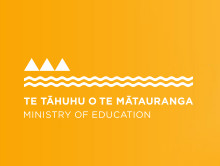I Muri i te Pānui Pukapuka
After Reading
Ka taea te whakamahi ēnei ngohe hei aromatawai, hei whakawhānui hoki i ngā pūkenga o ngā ākonga.
Possible assessment and extension activities.
1. Ākina ngā ākonga ki te matapaki i ngā pātai nei:
- He aha ngā akoranga matua ka mau i a tātou mai i tēnei pukapuka?
- He aha ngā mea kua akona mō te tuhi kōrero mō te tangata?
- Tēnā, whakaaturia he kōrero mō tētahi tangata rongonui ki te akomanga. Whakamahia ngā kupu hou me ngā rerenga kōrero hou kua akona mai i te kōrero.
Get students to discuss the following questions:
- What are the main ideas we have learnt from reading this book?
- What have we learnt about writing biographies?
- Present a biography poster to the class of an important person. Make sure students use new vocabulary and structure learnt from the book.
2. Me tautohu ngā tauira te reo raupapa i roto i te pukapuka, ka whakamārama atu ki ngā ākonga ka pēhea ēnei tauira e āwhina ai i te kaipānui ki te whai atu i te takanga mai o ngā mahi i roto i ngā kōrero. Hei tāpiri atu, me whakamārama atu mā te whakamahi i te maha atu o ngā momo tauira o te reo raupapa, ka pārekareka te kōrero.
Identify the sequence expressions in the book and talk to the students about how they help the reader follow the sequence of events. You could also talk about how the use of a variety of sequence expressions makes writing sound more interesting.
He hokinga whakamuri hei kōkiringa whakamua
Ideas for reflecting in learning and planning next learning steps
1. Me rangahau ngā ākonga ētahi ōritenga, ētahi rerekētanga hoki i waenganui i ngā kōrero ā-iwi o Aotearoa. Kia whakaaro rātou ki ngā mea pēnei i ngā āhuatanga ā-reo, ā-kawa, ā-tikanga, me te kaupapa o te kōrero hoki.
Encourage students to research other similarities and differences between the tribal stories of New Zealand. They should think about similarities and differences in things such as language, kawa, tikanga, and the moral of the story.
2. Hoatu tētahi kōrero taki anō mai i tētahi atu pukapuka ki ngā ākonga, ka akiaki i a rātou ki te tautohu i ētahi o ngā āhuatanga reo o te kōrero taki i kitea i te pukapuka Te Tautoko 69.
Give students another biography text from another book and ask them to identify some examples of the language features of recount text that they found in the stories in Te Tautoko 69.
Ngā Rauemi Tautoko
Resources
Te Ipurangi
He Pātaka Kupu
https://hepatakakupu.nz/
Ko te Ī-papakupu kei roto katoa i te reo Māori.
Mā tēnei hoki e māmā ai te rapu i ngā kupu taurite.
Te Ara
www.teara.govt.nz
He puna mōhiohio e mau nei i ngā pitopito kōrero, i ngā tāhuhu kōrero, i ngā whakaahua, i ngā kiriata hoki e pā ana ki Aotearoa.
Te Taura Whiri i te Reo Māori
www.tetaurawhiri.govt.nz
Ko ngā kōrero mō Te Taura Whiri i te Reo Māori me ngā kaupapa reo Māori o te wā.
Te Ao Hou
http://teaohou.natlib.govt.nz/journals/teaohou/index.html
Ko ngā moheni tawhito o Te Ao Hou. He nui ngā tuhituhinga reo Māori, ngā mihi, ngā poroporoaki, ngā pūrākau, ngā take tōrangapū, me ngā kaupapa maha e pā ana ki te ao Māori.
Ngā Pukapuka
Kawharu, M. (2008). Tāhuhu Kōrero: The Sayings of Taitokerau. Auckland: Auckland University Press.



